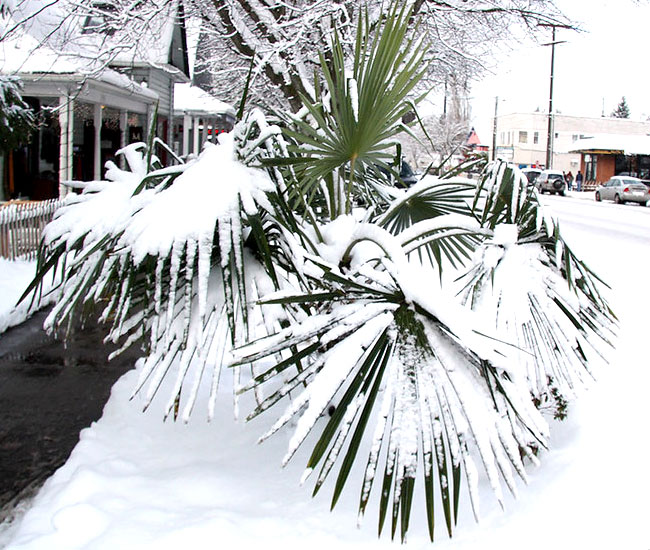
While cold-hardy palms can endure freezing temperatures, tropical palms might suffer damage when exposed to cold.
Typically, palm tree owners in warm climates don’t need to worry about chilly weather. However, with the unpredictability of recent winters, freezing temperatures have become less of a surprise.
Can Palm Trees Survive Cold Weather?
Cold-tolerant palms can weather temperatures around 10°-15°F, whereas tropical palms start encountering issues when the mercury dips below 45°F.
The critical factor here is the speed at which the temperature plunges. If it’s a swift drop from 60-70°F during the day to 45°F at night, even hardy palms can sustain damage.
On the flip side, a gradual temperature decline, day by day, provides palms with ample time to acclimatize to the cold and enter a dormancy stage. This helps them tolerate lower temperatures without significant harm.
The extent of damage also depends on several variables, such as the palm’s cold tolerance (cold hardiness), the time it’s been established, its age, overall health, nutrient levels, and its specific location in the yard.
Additionally, conditions can be worsened by cold, dry winds, the dehydrating afternoon sun, and the duration of the cold spell.
For those attempting to cultivate palms in temperate climates, it typically takes three full growing seasons for the tree to become fully established. If you’re dealing with heavy clay soil, the timeline may stretch even longer.
5 Steps To Saving A Freeze Damaged Palm Tree
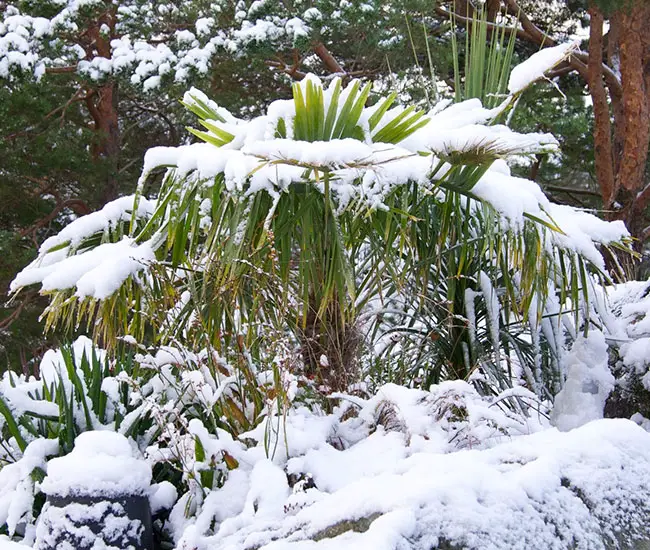
It might take a few weeks or even months to detect the signs of winter damage. Initially, the palm may appear entirely normal, but as time passes, you may notice new leaves emerging in a deformed and partially browned state.
By the end of spring, you’ll have a clearer idea of whether your palm tree needs replacement. Now, let’s dive into the steps you can take to salvage it.
Step 1: Cleaning
First, you need to assess the extent of the damage. To determine the severity, gently pull the newly emerging spear. In some cases, the new spear may be loose and easily pulled out. If this happens, clean out the hollow area with water.
Create a small hole just below the leaf bases to prevent water accumulation, which can lead to new growth rot. Examine whether the bud is still alive. If it’s green, the palm tree can be rescued; if it’s mushy, it’s time to grab the shovel.
Step 2: Spray Liquid Copper Fungicide
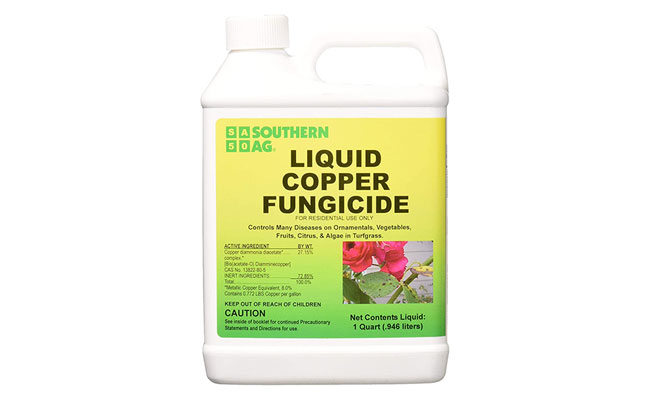
Next, protect the palm from bacterial and fungal threats. Spray the palm with liquid Copper Fungicide. Following a freeze, palm trees become more susceptible to bacterial and fungal infections.
Copper Fungicide boasts a unique formula that combats both types of threats. Apply it no more than twice, with a 10-day gap between each application. Thoroughly drench the palm’s bud with liquid copper, utilizing the spray’s force to cleanse it. This reduces the risk of bud rot caused by microorganisms.
Applying Copper Fungicide around the base of the palm will also curb the development of root diseases. One highly effective product I’ve found is “Liquid Copper Fungicide” by Southern Ag, which effectively fights fungi and bacteria.
Step 3: Pruning
Wait for a month or two before considering any pruning of fronds. Focus on removing only dead branches and clear away all the withered leaves around the bud to facilitate drying.
Avoid cutting back leaves with brown tips, as palms still extract nutrients for new growth from these fading fronds.
Be careful not to over-prune, as the more green leaves you remove, the less food the palm can manufacture. Pruning too many leaves will only heighten the tree’s stress.
Step 4: Antitranspirant Spray
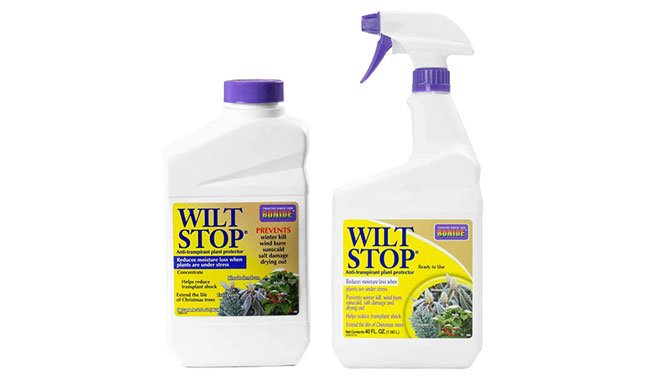
As mentioned earlier, cold damage to the trunk or roots can hinder the palm’s ability to supply water to its leaves. Applying an antitranspirant spray can help reduce water loss from the foliage during cold weather.
Antitranspirant spray forms a transparent film on the plant’s foliage, preserving moisture and minimizing water loss during periods of stress.
One product I recommend is ‘Wilt Stop’ by Bonide, which can be used at the outset of the cold season as one way to safeguard your palm tree from the cold.
Step 5: Fertilizing
Do NOT rush to fertilize your palm trees; wait until late summer or fall. Many people commence fertilizing as soon as they spot brown leaves. It’s crucial to understand that fertilizer is NOT plant food.
Despite labels that may read “Palm Food” or “Plant Food,” fertilizer is essentially a blend of nutrients designed to enrich the soil and foster plant growth. Plants generate their own nourishment using water, carbon dioxide, and solar energy.
Consider fertilizers as vitamin supplements. You can’t make a weakened, malnourished person healthy with vitamins alone.
Similarly, when you fertilize a struggling palm tree too early, you’re essentially asking it to initiate growth, which can exacerbate its stress. It’s best to wait until late summer or spring and then apply a slow-release fertilizer.
For more fertilizing tips read my article on Fertilizing Palm Trees.
3 Types of Palm Tree Winter Damage
There are three types of winter damage that your palm tree can endure: cold, frost, and freeze. The most crucial and vulnerable part of the palm tree is the bud, where new leaves emerge.
If the bud tissue of the palm has not been severely damaged, the palm should recover and begin producing new leaves during the following summer.
The emerging leaves may appear deformed, partially brown, or exhibit other abnormalities. It can take anywhere from 6 months to a year from the freeze for the palm tree to fully recover.
However, if the bud tissue has been significantly harmed, the palm may not survive.
1. Cold Damage to Palms
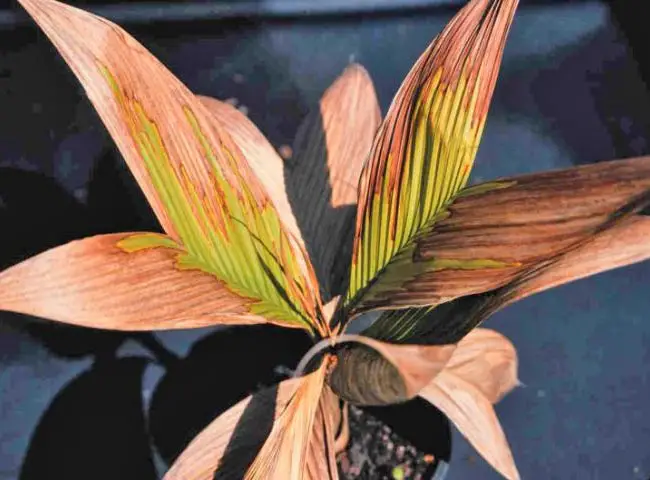
When a palm is damaged by cold temperatures, you may notice curling and yellowish-brown discoloration on the older fronds.
New growth that emerges in the following months might exhibit slower growth than usual. In some cases, new spears may fail to open.
These are all signs of prolonged exposure to cold weather, and they typically resolve on their own after a few months when temperatures return to normal.
2. Palm Frost Damage
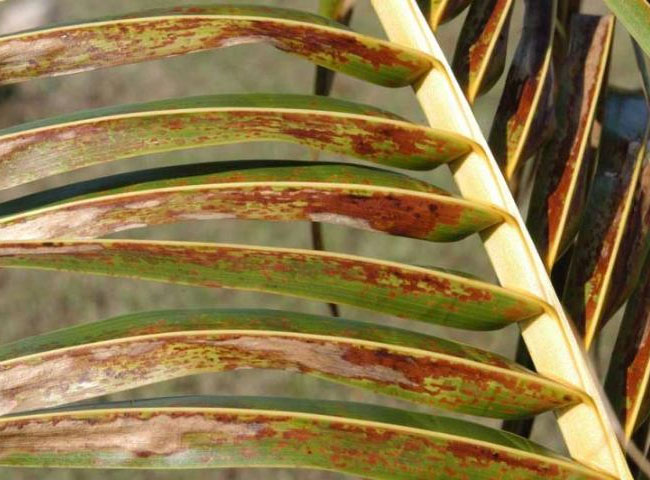
Frost can be particularly devastating to palms, especially those with low cold tolerance. It often blankets the entire foliage, causing harm to the leaves and sometimes even the bud.
A few days or weeks after frost exposure, you may observe severe discoloration on the fronds, appearing as a dark chocolate-brown or even black color. This is a clear indication of significant damage.
3. Freeze Damage to Palms
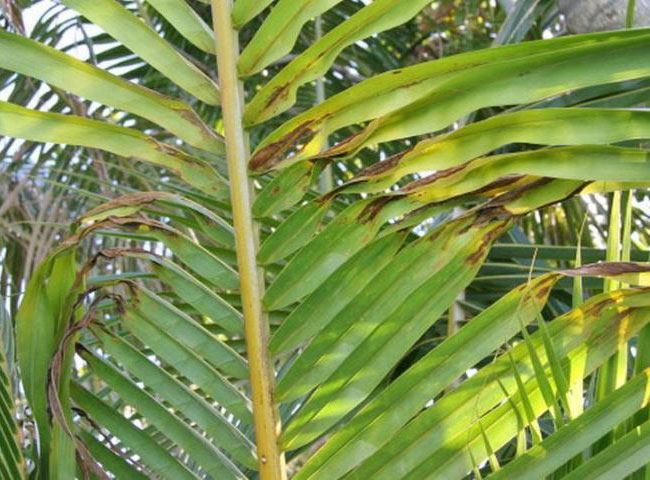
Freezing temperatures at or below 32°F can prove fatal for most tropical palms if they lack adequate winter protection. After enduring freezing conditions for an extended period, the palm may lose most or all of its foliage.
Several months or even a year following the freeze, you may notice vertical cracks on the trunk and the crownshaft. A bent trunk, an unpleasant odor, and a soft, mushy crown below the spear all signify severe damage.
Damage to the trunk tissue from freezing will restrict the tree’s ability to supply water to the foliage. Unlike regular trees, palms cannot regenerate trunk tissue. A collapsing crown may be an indication that this type of damage has occurred.
Signs and Severity Of Palm Tree Cold Damage
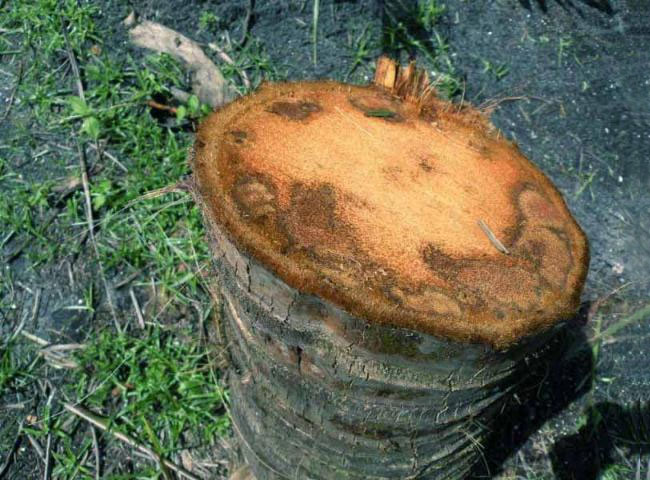
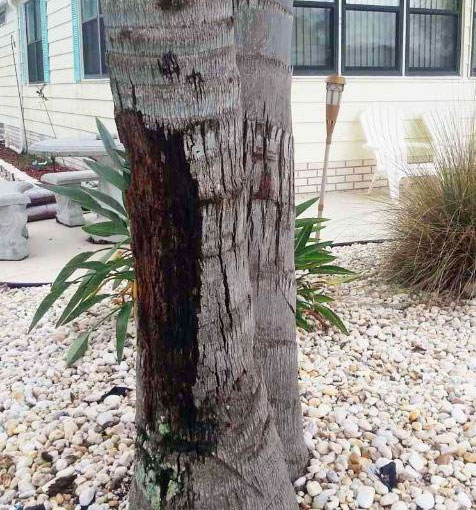
I’ve created a chart to illustrate the various signs of winter damage and their corresponding severity levels.
Low severity suggests that the palm will likely recover later in the season, while medium severity indicates a chance of serious injury with an uncertain outcome.
High severity suggests that your palm tree may not survive.
| Signs of Damage | Severity |
| New growth is green and brown | Low |
| New growth is growing at a slow rate | Low |
| Old leaves are yellowish-brown | Low |
| Old leaves are curling | Low |
| Old leaves are brown or black | Medium |
| New growth is deformed | Medium |
| New growth pulls out easily | Medium |
| New growth is brown or black | High |
| Crown is soft and mushy | High |
| Vertical cracks in the trunk | High |
| Strong odor coming from the bud or trunk | High |
| Collapsing or bending trunk | High |
How to Protect Your Palm Tree from Freeze in the Future
To safeguard your palms from the cold, consider the various methods outlined in my detailed article titled ‘10 Ways to Protect Palm Trees from Winter Freeze.’
These simple techniques work best if you anticipate more cold weather in the forecast. It’s wise to take measures to protect your palm from further damage.
- Fertilization: Supplying the right nutrients in the months leading up to winter is crucial for preparing your palm for the cold.
- Heavy Mulching: Adding 4-6 inches of mulch helps safeguard the tree’s roots from freezing.
- Heavy Watering: Providing extra water before a cold snap ensures an ample water supply and helps prevent root freezing.
- Antitranspirant Spray: This forms a clear film around the leaves, reducing water loss from the foliage.
- Copper Fungicide: An effective solution against bacterial and fungal infections.
- Warm Cover: Use blankets, burlap, or other insulating materials to drape over the palm.
- Palm Trunk and Foliage Wrapping: Wrap warm material around the trunk and canopy, securing it with duct tape.
- Heater and Light Bulbs. You can utilize a propane heater or Christmas lights as additional heat sources.
- Heat Cables. These come with a built-in thermostat and can be employed around the trunk or roots.
- Temporary Greenhouse. Construct a wooden frame above the tree and cover it with double plastic sheeting, securing it to the frame.
Just remember, taking these precautions is way easier than trying to save a palm tree after it’s been through a winter beating. Rescuing a frosty palm takes some patience, but when it’s really bad, there might not be much you can do.
Related articles:
- 10 Ways To Protect Palm Trees From Winter Freeze, Cold, and Frost
- Top 20 Palm Trees That Can Survive Freezing Weather
- 10 Expert Tips On Growing Palm Trees In Cold Climates
- Secret to Growing Cold Hardy Palm Trees

I have a European Fan Palm that was hit hard by an ice storm in Ga last year. The main stalk appears to have died. (it did not put out any green this year na dthe leaves all died) I do have the pups or suckers that are still green. Have I lost this palm or is there still hope?
about 2 months ago a tree company came in to prune this 40 foot palm tree and the guy removed all the old growth about 10 feet under where leaves are growing about 25 feet from the base. How can we save it
something is causing my palm leaves on my adonidia to drop. I did see a black rat jump out and wonder if they are chewing the branches, At the rate they are dropping, I am afraid I will lose the trees. Any help you can give would be appreciated.
I just unwrapped my windmill palm from winterizing. He’s still a little guy. He has about 3 brown fronds on the outside, all the rest and in the middle are still green. I live in Illinois, zone 5. I was thinking about putting 1 jobes 10-5-10 by trunk to give it a boost. Thoughts? Tips?
I HAVE A 1APPROX 15 FT QUEEN PALM I PLANTED LAST SPRING.. IT WAS DOING GREAT AND SPROUTING NEW FONDS. AND THEN WE HAD THE FREEZE IN HOUSTON ..IT WAS AROUND 17 DEGREES FOR ONE DAY… AFTER THE FREEZE THE PALM STILL LOOKED OK …HOWEVER AFTER SEVERAL WEEKS THE FONDS ON LOWER PART OF PALM DIED… i PRUNED THE PALM AND THERE WAS STILL SOME GREEN IN THE CENTER COMING OUT ..BUT NOW THERE IS NONE. MY NEIGHBOR HAS A SMALL QUEEN ABOUT 8 FT FROM MINE ON THE OTHER SIDE OF THE FENCE AND HIS LOOKS OK… ANY THOUGHTS ON WHAT I CAN DO OR DO YOU THINK MY PALM IS DEAD.? IT WAS DOING SO WELL.. I HATE TO GIVE UP ON IT…
YOUR ADVISE IS GREATLY APPRECIATED
Regaards
Robert Hughey
I have a beautiful Mule Palm. (4 yrs old) Up to a month ago It was fine. I had some people trim brown branches as I could not reach them. I came home and now the palm is dying. All the branches on one side are brown. We sprayed it with Copper Fungicide but it is still dying. What can we do?
How long do you wait to see new growth? You say summer – does that mean waiting until June 21 or later?
my palm tree with a triple palm was damaged. one of the palms was broke by a fallen tree. I tied it up but it didn”t
seem to help at all. all frones were dead and the damaged palm seems to be dead. What can i do with the repair.
My Bismarck Palm which I planted 10 months ago was hit by the frost. All of the fronds are brown except for the very beginning of the fronds where they spread out from the base. There is a new spear that emerged before the frost. It appears to be green when I gently open the spear itself. What should I do?
I have several queen palms that just went through a hard freeze. All of the fronds on all the trees are now beige/light brown not just the tips. Do i prune them all or just the older ones? I also have Phoenix palms that are also burnt/ frozen. Do i prune all the brown frm them as well?? PLEASE HELP!
HELP I live in Asheboro NC near greensbor and my palm is in bad shape.
I think it is a windmill palm but I could be wrong. It’s about 10 feet tall and the cold and snow really did a number on it. I don’t know if I should remove all the damaged frawns or leave to top ones until warmer weather? I know nothing so anyone who can guide would be greatly appreciated
In south Louisiana I have 12 mature queens. We had 2 days of temps in the teens at night and below freezing during the day. After a couple weeks all the founs turned brown. Do you think my palms are dead? Is there Anything I can do to help them?
Our foxtail palm took a hit with the cold this winter, all the crimes are brown we had one new shoot started before the cold hit, the outer cover is brown but there is green poking thru and we green color in the trunk, what can we do to save it? Does Epson salt water work?
Hi Katrin. I’ve read through your blog about caring for palms from a cold freeze. As you know and are probably overwhelmed with emails from this past years freeze our palms aren’t doing well here in central Florida. We have 2 foxtails that were planted by a nursery last May that are having a hard time coming out of it. They were beautiful till the freeze came through. I spoke with the woman at the nursery and she told me to trim them back to the last frond and to clip the tip of it to help it open. She also told me to fertilize and water it. I’ve done all those things but they are still in stress. The trunk is still very green. I’ve noticed the rest of the foxtails in our neighborhood, the trunks are brown or black. We wrapped ours with a blanket during the freeze. Any chance our foxtails will come out of it or do you feel they are too far gone? Thanks for reading and I hope to hear from you.
Mature queen palms 8 years old in the ground last freeze lost all fronds trunk is solid it’s been 8 months no green no rot apparent how to resolve